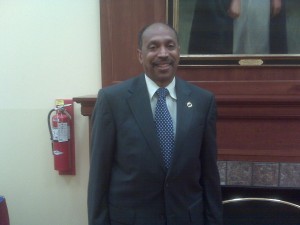LISTEN TO ANC COMMISSIONER STEPHEN WHATLEY HERE
Audio clip: Adobe Flash Player (version 9 or above) is required to play this audio clip. Download the latest version here. You also need to have JavaScript enabled in your browser.
Walter Reed Medical Center has secrets. In its Pulitzer Prize winning series in 2007, the Washington Post revealed a few of Walter Reed’s more recent secrets when it exposed the inadequate conditions and care injured soldiers were being subjected to. But the Post didn’t discuss Walter Reed’s older and darker secrets. As 62.5 acres of the 113 acre campus is being turned over from the military to the District, it’s time to come clean about Walter Reed’s history.
Stephen Whatley is chair of Advisory Neighborhood Commission 4A, which includes Walter Reed. Seven or eight years ago, men in orange hazmat suits were swarming around the campus, said Whatley.  Nobody, not even Walter Reed’s immediate neighbors, including Whatley, has been given an explanation for the individuals in the hazmat suits. Whatley questions whether they were searching for something that had escaped from the Armed Forces Institute of Pathology.
Nobody, not even Walter Reed’s immediate neighbors, including Whatley, has been given an explanation for the individuals in the hazmat suits. Whatley questions whether they were searching for something that had escaped from the Armed Forces Institute of Pathology.
Nearly 150 years ago, during the Civil War, the Armed Forces Institute of Pathology was created to help diagnose and study illnesses impacting Union troops. Today, it has a repository of 95 million tissue samples of all sorts of diseases and viruses ranging from the H1N1 to anthrax to the Ebola virus to the Spanish Flu from 1918-1919. Chair Whatley questioned how this secretive institute disposes of all of these earthly terrors.
Then there’s Building 40. From 1972-1975, Jim Weil worked in its basement. Despite being situated on a secure military base, Building 40 was carefully guarded around the clock, said Weil. He is certain that the security was due to the nuclear reactor located in the basement. Weil’s assertion that Building 40 housed a nuclear reactor was recently confirmed by the Washington Post: “[O]ne building contains a small nuclear reactor switched on by the Walter Reed Army Institute of Research in 1962 to study nuclear medicine.” Interestingly, Building 40 is the only building on the campus that has been leased to private interests.
City Administrator Neil Albert is one of those heading up the redevelopment of Walter Reed. I asked Mr. Albert if he is aware of any environmental problems with the campus. He said the military was working closely with the District and there was “nothing to worry about.” I then asked Mr. Albert if there was a nuclear reactor at Walter Reed. He replied, “Not to my knowledge.” While the military has been less than transparent in this process, the District has been worse.
At a community meeting, the Director of the Office of Planning, had a novel idea. Harriet Tregoning proposed placing a parking lot over the more polluted areas of Walter Reed. Possibly even more disturbing than Tregoning’s proposal is that neither the District nor the military is required to do environmental testing before construction begins. In my interview with Neil Albert, I said, “If I understand correctly, the environmental cleanup is not necessarily done before building starts, [but] the environmental plan is put together before building starts.” Albert replied, “Absolutely.”
Drawing up environmental plans may be useful, but doing the actual environmental testing is essential. Chair Whatley has called for an independent soil analysis to be conducted prior to any construction. His sensible request has fallen on deaf ears. In the rush to build, let’s hope the District is not making a mistake that we will regret.
